2017 KIA CARENS RHD fuel
[x] Cancel search: fuelPage 670 of 723
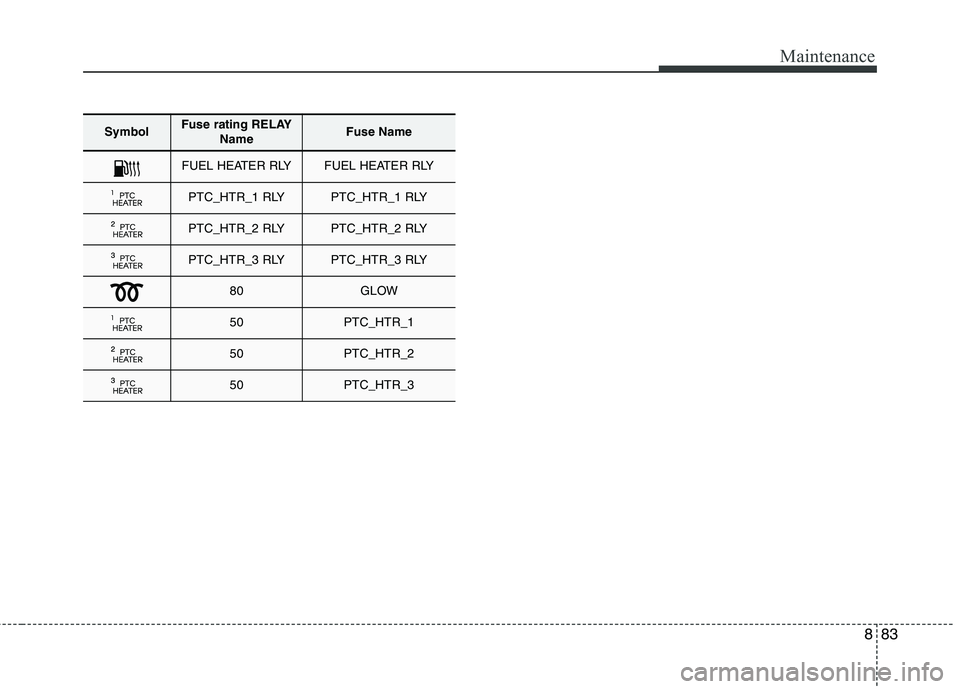
883
Maintenance
SymbolFuse rating RELAYNameFuse Name
FUEL HEATER RLYFUEL HEATER RLY
PTC_HTR_1 RLYPTC_HTR_1 RLY
PTC_HTR_2 RLYPTC_HTR_2 RLY
PTC_HTR_3 RLYPTC_HTR_3 RLY
80GLOW
50PTC_HTR_1
50PTC_HTR_2
50PTC_HTR_3
Page 690 of 723
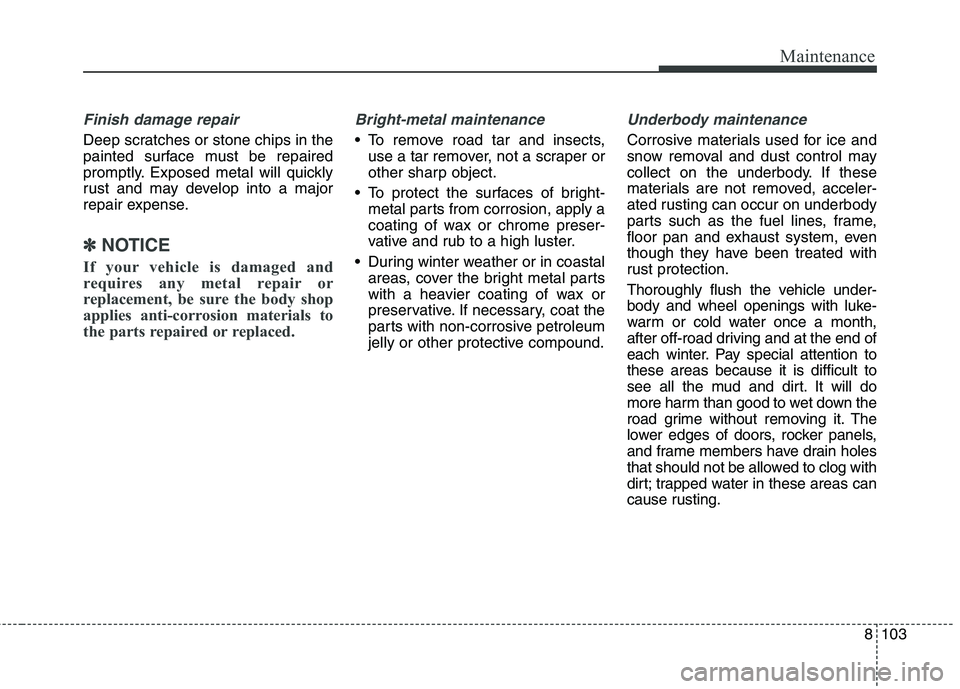
8103
Maintenance
Finish damage repair
Deep scratches or stone chips in the
painted surface must be repaired
promptly. Exposed metal will quickly
rust and may develop into a major
repair expense.
✽✽NOTICE
If your vehicle is damaged and
requires any metal repair or
replacement, be sure the body shop
applies anti-corrosion materials to
the parts repaired or replaced.
Bright-metal maintenance
To remove road tar and insects, use a tar remover, not a scraper or
other sharp object.
To protect the surfaces of bright- metal parts from corrosion, apply a
coating of wax or chrome preser-
vative and rub to a high luster.
During winter weather or in coastal areas, cover the bright metal parts
with a heavier coating of wax or
preservative. If necessary, coat the
parts with non-corrosive petroleum
jelly or other protective compound.
Underbody maintenance
Corrosive materials used for ice and
snow removal and dust control may
collect on the underbody. If these
materials are not removed, acceler-
ated rusting can occur on underbody
parts such as the fuel lines, frame,
floor pan and exhaust system, even
though they have been treated with
rust protection.
Thoroughly flush the vehicle under-
body and wheel openings with luke-
warm or cold water once a month,
after off-road driving and at the end of
each winter. Pay special attention tothese areas because it is difficult to
see all the mud and dirt. It will do
more harm than good to wet down the
road grime without removing it. The
lower edges of doors, rocker panels,
and frame members have drain holes
that should not be allowed to clog with
dirt; trapped water in these areas can
cause rusting.
Page 696 of 723

8109
Maintenance
EMISSION CONTROL SYSTEM
The emission control system of your
vehicle is covered by a written limited
warranty. Please see the warranty
information contained in the Service
Passport in your vehicle.
Your vehicle is equipped with an emission control system to meet all
emission regulations. There are three emission control
systems which are as follows.
(1) Crankcase emission control sys- tem
(2) Evaporative emission control sys- tem
(3) Exhaust emission control systemIn order to assure the proper function
of the emission control systems, it is
recommended that you have your
car inspected and maintained by an
authorised Kia dealer in accordance
with the maintenance schedule. Caution for the Inspection and
Maintenance Test (With Electronic
Stability Control (ESC) system)
To prevent the vehicle from mis-
firing during dynamometer test-
ing, turn the Electronic Stability
Control (ESC) system off by
pressing the ESC switch.
After dynamometer testing is completed, turn the ESC system
back on by pressing the ESC
switch again.
1. Crankcase emission control system
The positive crankcase ventilation
system is employed to prevent air
pollution caused by blow-by gases
being emitted from the crankcase.This system supplies fresh filtered air
to the crankcase through the air
intake hose. Inside the crankcase,
the fresh air mixes with blow-by
gases, which then pass through the
PCV valve into the induction system. 2. Evaporative emission con-
trol System
The Evaporative Emission Control
System is designed to prevent fuel
vapours from escaping into the
atmosphere.
Canister
Fuel vapours generated inside the fuel tank are absorbed and stored in
the onboard canister. When the
engine is running, the fuel vapours
absorbed in the canister are drawninto the surge tank through the purge
control solenoid valve.
Purge Control Solenoid Valve (PCSV)
The purge control solenoid valve is
controlled by the Engine Control
Module (ECM); when the engine
coolant temperature is low during
idling, the PCSV closes so that evap-
orated fuel is not taken into the
engine. After the engine warms-up
during ordinary driving, the PCSV
opens to introduce evaporated fuel to
the engine.
Page 698 of 723
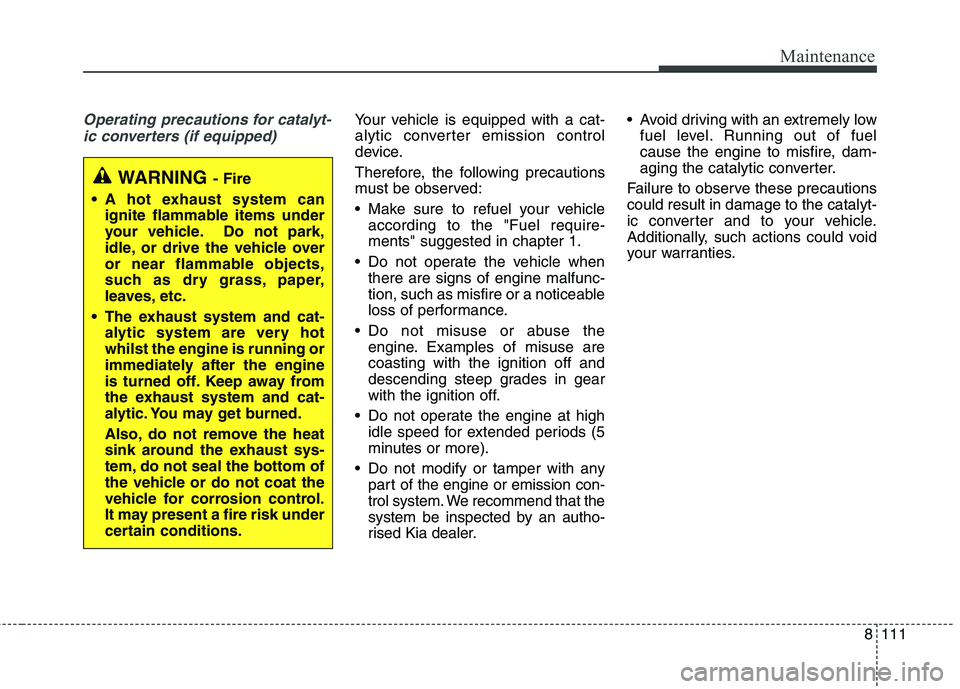
8111
Maintenance
Operating precautions for catalyt-ic converters (if equipped)Your vehicle is equipped with a cat-
alytic converter emission control
device.
Therefore, the following precautions
must be observed:
Make sure to refuel your vehicle according to the "Fuel require- ments" suggested in chapter 1.
Do not operate the vehicle when there are signs of engine malfunc-
tion, such as misfire or a noticeable
loss of performance.
Do not misuse or abuse the engine. Examples of misuse arecoasting with the ignition off and
descending steep grades in gear
with the ignition off.
Do not operate the engine at high idle speed for extended periods (5
minutes or more).
Do not modify or tamper with any par t of the engine or emission con-
trol system. We recommend that the
system be inspected by an autho-
rised Kia dealer. Avoid driving with an extremely low
fuel level. Running out of fuel
cause the engine to misfire, dam-
aging the catalytic converter.
Failure to observe these precautionscould result in damage to the catalyt-
ic converter and to your vehicle.
Additionally, such actions could void
your warranties.
WARNING - Fire
A hot exhaust system can ignite flammable items under
your vehicle. Do not park,
idle, or drive the vehicle over
or near flammable objects,
such as dry grass, paper,
leaves, etc.
The exhaust system and cat- alytic system are very hotwhilst the engine is running or
immediately after the engine
is turned off. Keep away from
the exhaust system and cat-
alytic. You may get burned.
Also, do not remove the heat
sink around the exhaust sys-
tem, do not seal the bottom of
the vehicle or do not coat the
vehicle for corrosion control.
It may present a fire risk under
certain conditions.
Page 699 of 723
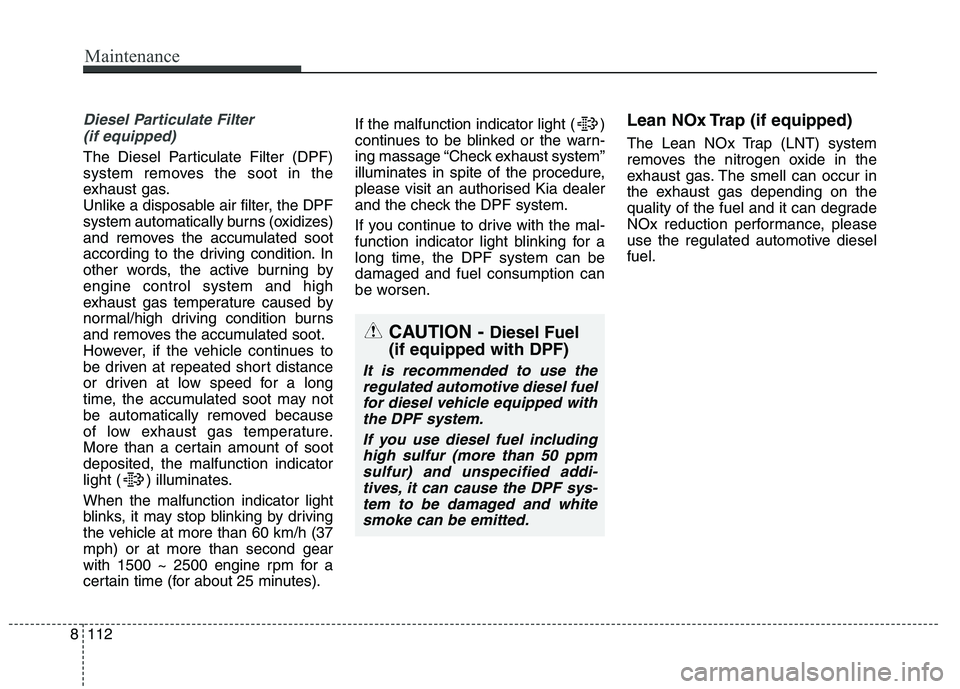
Diesel Particulate Filter (if equipped)
The Diesel Particulate Filter (DPF)
system removes the soot in the
exhaust gas.
Unlike a disposable air filter, the DPF
system automatically burns (oxidizes)
and removes the accumulated soot
according to the driving condition. In
other words, the active burning byengine control system and high
exhaust gas temperature caused by
normal/high driving condition burns
and removes the accumulated soot.
However, if the vehicle continues to
be driven at repeated short distance
or driven at low speed for a long
time, the accumulated soot may not
be automatically removed because
of low exhaust gas temperature.
More than a certain amount of sootdeposited, the malfunction indicator
light ( ) illuminates. When the malfunction indicator light
blinks, it may stop blinking by driving
the vehicle at more than 60 km/h (37mph) or at more than second gear
with 1500 ~ 2500 engine rpm for a
certain time (for about 25 minutes). If the malfunction indicator light ( )
continues to be blinked or the warn-
ing massage “Check exhaust system”
illuminates in spite of the procedure,
please visit an authorised Kia dealer
and the check the DPF system.
If you continue to drive with the mal-
function indicator light blinking for a
long time, the DPF system can bedamaged and fuel consumption can
be worsen.
Lean NOx Trap (if equipped)
The Lean NOx Trap (LNT) system
removes the nitrogen oxide in the
exhaust gas. The smell can occur in
the exhaust gas depending on the
quality of the fuel and it can degrade
NOx reduction performance, please
use the regulated automotive dieselfuel.
CAUTION -
Diesel Fuel
(if equipped with DPF)
It is recommended to use the regulated automotive diesel fuelfor diesel vehicle equipped with the DPF system.
If you use diesel fuel includinghigh sulfur (more than 50 ppmsulfur) and unspecified addi-tives, it can cause the DPF sys- tem to be damaged and whitesmoke can be emitted.
8112
Maintenance
Page 707 of 723
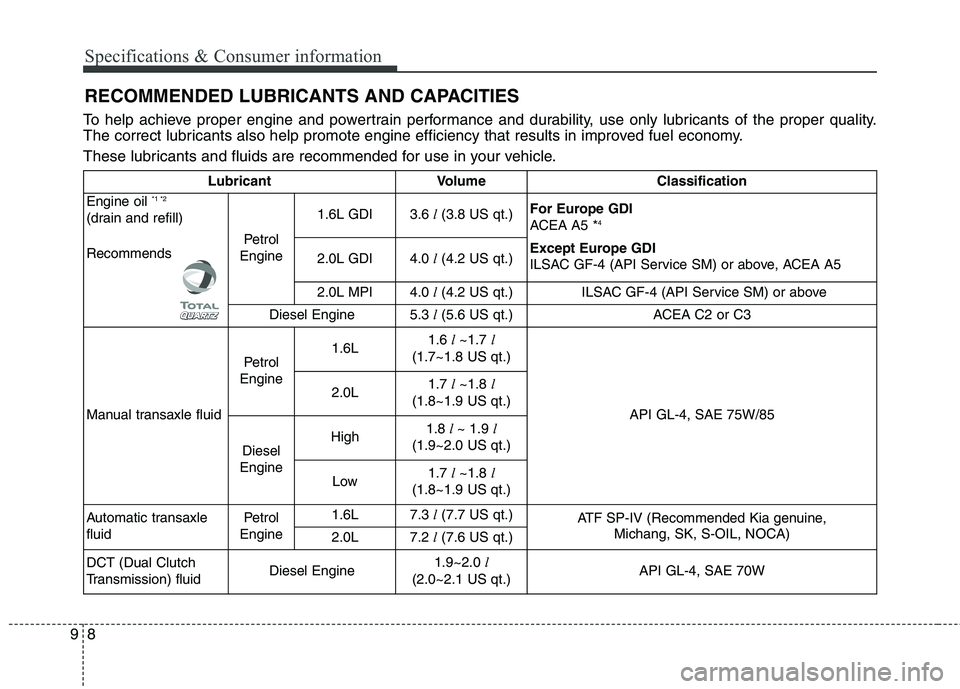
Specifications & Consumer information
8
9
RECOMMENDED LUBRICANTS AND CAPACITIES
To help achieve proper engine and powertrain performance and durability, use only lubricants of the proper quality.
The correct lubricants also help promote engine efficiency that results in improved fuel economy.
These lubricants and fluids are recommended for use in your vehicle.
Lubricant Volume Classification
Engine oil *1 *2
(drain and refill) Recommends Petrol
Engine 1.6L GDI
3.6
l(3.8 US qt.) For Europe GDI
ACEA A5 *
4
Except Europe GDI
ILSAC GF-4 (API Service SM) or above, ACEA A5
2.0L GDI
4.0
l(4.2 US qt.)
2.0L MPI4.0 l(4.2 US qt.)ILSAC GF-4 (API Service SM) or above
Diesel Engine 5.3
l(5.6 US qt.)
ACEA C2 or C3
Manual transaxle fluid Petrol
Engine 1.6L
1.6
l~1.7 l
(1.7~1.8 US qt.)
API GL-4, SAE 75W/85
2.0L1.7 l~1.8 l
(1.8~1.9 US qt.)
Diesel
Engine High
1.8
l ~ 1.9 l
(1.9~2.0 US qt.)
Low 1.7
l~1.8 l
(1.8~1.9 US qt.)
Automatic transaxle fluid Petrol
Engine 1.6L
7.3
l(7.7 US qt.)
ATF SP-IV (Recommended Kia genuine,
Michang, SK, S-OIL, NOCA)
2.0L 7.2
l(7.6 US qt.)
DCT (Dual Clutch
Transmission) fluid Diesel Engine1.9~2.0
l
(2.0~2.1 US qt.) API GL-4, SAE 70W
Page 708 of 723

99
Specifications & Consumer information
Lubricant Volume Classification
Coolant
Petrol Engine
1.6LM/T6.2l(6.6US qt.)
Mixture of antifreeze and distilled water
(Ethylene glycol base coolant for aluminum radiator)A/T6.0l(6.3US qt.)
2.0LM/T6.3 l(6.7US qt.)
A/T6.0 l(6.3US qt.)
Diesel
EngineM/T7.0 l~ 7.1 l
DCT7.0l~ 7.1 l
Brake/clutch fluid0.7~0.8 l
(0.7~0.8 US qt.)FMVSS116 DOT-3 or DOT-4
Fuel 58 l (15.3 US gal.) Refer to “Fuel requirements” in chapter 1
*1
Refer to the recommended SAE viscosity numbers on the next page.
* 2
Engine oils labeled Energy Conserving Oil are now available. Along with other additional benefits, they contribute to fuel economy by reducing
the amount of fuel necessary to overcome engine friction. Often, these improvements are difficult to measure in everyday driving, but in a year’s
time, they can offer significant cost and energy savings.
* 3
Diesel Particulate Filter
* 4
If you replace the engine oil, we recommend to contact a Kia workshop or equally qualified workshop.
M/T: Manual transaxle
A/T: Automatic transaxle
Recommends Engine Oil (For Europe)
SupplierDiesel Engine
ShellHELIX ULTRA AP 5W-30
HELIX ULTRA AP-L 5W-30
Page 709 of 723
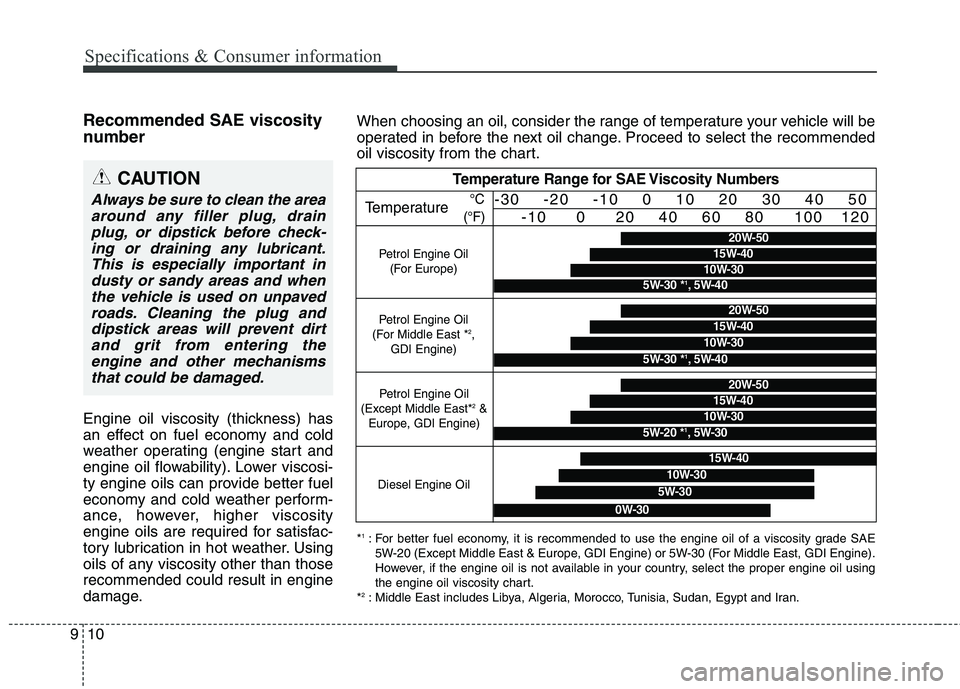
Specifications & Consumer information
10
9
Recommended SAE viscosity
number
Engine oil viscosity (thickness) has
an effect on fuel economy and cold
weather operating (engine start and
engine oil flowability). Lower viscosi-
ty engine oils can provide better fuel
economy and cold weather perform-
ance, however, higher viscosity
engine oils are required for satisfac-
tory lubrication in hot weather. Using
oils of any viscosity other than thoserecommended could result in engine
damage. *
1
: For better fuel economy, it is recommended to use the engine oil of a viscosity grade SAE
5W-20 (Except Middle East & Europe, GDI Engine) or 5W-30 (For Middle East, GDI Engine).
However, if the engine oil is not available in your country, select the proper engine oil using
the engine oil viscosity chart.
* 2
: Middle East includes Libya, Algeria, Morocco, Tunisia, Sudan, Egypt and Iran.
CAUTION
Always be sure to clean the area
around any filler plug, drainplug, or dipstick before check- ing or draining any lubricant.This is especially important industy or sandy areas and when the vehicle is used on unpavedroads. Cleaning the plug anddipstick areas will prevent dirtand grit from entering the engine and other mechanismsthat could be damaged.
When choosing an oil, consider the range of temperature your vehicle will be
operated in before the next oil change. Proceed to select the recommended
oil viscosity from the chart.
Temperature Range for SAE Viscosity Numbers
Temperature
Petrol Engine Oil (For Europe)
°C
(°F)-30 -20 -10 0 10 20 30 40 50 -10 0 20 40 60 80 100 120
Petrol Engine Oil
(For Middle East * 2
,
GDI Engine)20W-50
10W-30
15W-40
5W-30 * 1
, 5W-40
20W-50
10W-30
15W-40
5W-30 * 1
, 5W-40
Diesel Engine Oil 5W-30
15W-40
10W-30
0W-30
Petrol Engine Oil
(Except Middle East* 2
&
Europe, GDI Engine)20W-50
10W-30
15W-40
5W-20 * 1
, 5W-30